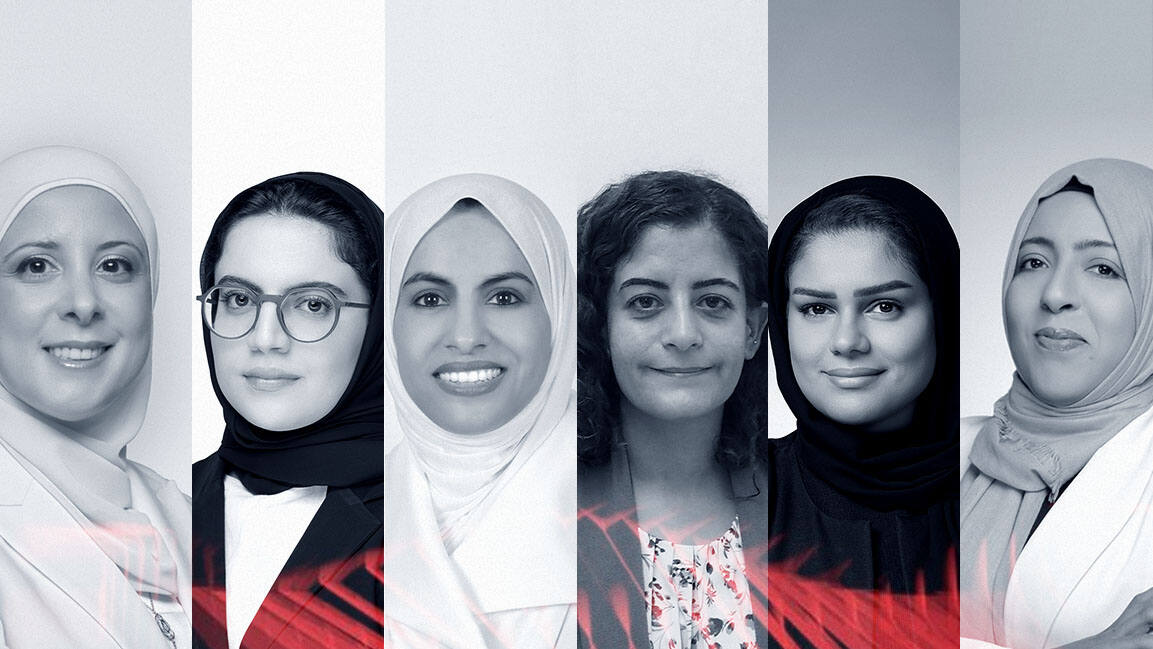- | 10:00 am
These six women are breaking barriers in STEM in the Arab world
Six women in STEM are overcoming barriers and driving innovation in critical fields.

In a region where women in STEM face numerous barriers—from societal expectations to limited access to funding—success often feels like an uphill battle. Yet, the six winners of the L’Oréal-UNESCO For Women in Science Program 2024 have scaled these steep slopes with ease, making groundbreaking contributions in fields critical to the Arab world’s future.
Their work, spanning critical fields like health, clean energy, and climate change, is advancing scientific progress in the Arab world. It also serves as a powerful reminder of the untapped potential of empowering women in science.
In an interview with Fast Company Middle East, they spoke about the obstacles they’ve overcome, the passion that drives their work, and their commitment to making lasting changes in their respective fields.
BREAKING BARRIERS IN STEM
The growing success of women in STEM is driven by increased access to education, strong mentorship, and supportive workplace policies, believes Israa Al Hussain Al Hassan Othman, Sudanese PhD candidate at Khalifa University.
Early outreach programs and diverse role models have inspired more women to enter and stay in these fields, while organizational shifts toward inclusivity and diversity provide a favorable environment for their advancement. Additionally, targeted funding and research support have enabled women to lead in groundbreaking scientific work, creating a cycle of visibility and opportunity that fuels continued progress.
Taiba Alamoudi, a Saudi Arabian PhD candidate in Marine Science at the King Abdullah University of Science and Technology (KAUST), echoes this sentiment, highlighting that the increasing success of women in STEM is a result of greater access to education, focused efforts on promoting gender equity, and the visibility of female role models. “Scholarship programs, mentorship initiatives, and support networks specifically designed for women in STEM have opened pathways for more women to not only enter but excel in these fields,” she adds.
Educational institutions and organizations have also adopted policies that promote diversity, making STEM fields more accessible and inclusive. “Importantly, society’s view on gender roles has evolved, and there is a stronger understanding of the importance of diverse perspectives in driving innovation. This shift is supported by research showing that gender-diverse teams often achieve better outcomes, incentivizing institutions to foster inclusivity.”
There has been increased global awareness of the gender disparity in STEM and active measures to bridge the gap, adds Fatima Alshamsi, Emirati PhD candidate at Khalifa University.
Seeing successful women in STEM, from Nobel laureates to leading scientists in healthcare advancements like COVID-19 vaccines, has inspired a new generation of women to believe in their potential. She emphasizes, “Societal attitudes are gradually changing, and there’s more recognition of the importance of diversity in scientific research, which has encouraged institutions and governments to invest in women scientists.”
CLOSING THE GENDER GAP
The gender gap in STEM partly reflects demographic factors.
In regions like the Gulf, many women researchers are still in the early stages of their careers and have yet to reach senior positions—a shift that is expected to occur gradually, according to Dr. Hiam Souheil, Chemaitelly Lebanese Assistant Professor of Research in Population Health Sciences at Weill Cornell Medicine-Qatar. However, she notes that structural barriers persist, particularly regarding balancing family and career responsibilities.
She emphasizes that practical solutions, such as accessible childcare, flexible work options, and scholarships, are crucial to supporting women’s advancement in STEM. “Addressing these needs will enable more women to thrive and reach leadership roles,” she says.
Several cultural and social factors contribute to this disparity, and while progress has been made, more needs to be done to fully address it, says Dr. Entessar Al-Hetlani, a Kuwaiti Professor at Kuwait University.
One effective strategy, she suggests, is introducing young girls to STEM subjects early. “Awareness programs in schools and communities that offer hands-on activities, mentorship, and role models can inspire young girls to pursue careers in STEM,” she explains.
For example, she explains how she participated in a summer program that promotes science communication for both secondary and high school students. It was observed that more young girls participated compared to boys, and they already had serious plans for their future careers. This program broadened their horizons and clarified misconceptions about various fields of science, demonstrating the positive impact of such initiatives.
To effectively close the gender gap in STEM, we need to implement comprehensive strategies that include policy changes and reforms that tackle biases against women, says Dr. Leena Ali Ibrahim, Palestinian-Bulgarian Assistant Professor of Bioscience at King Abdullah University of Science and Technology (KAUST).
This involves implementing flexible work policies, requiring bias training, establishing supportive networks for sharing experiences, and mentorship opportunities. Such measures will create a more supportive environment in STEM fields, allowing women to thrive.
MYTHS VS. REALITIES IN STEM
One common myth is that women in STEM have to sacrifice their personal lives or passions to be successful, says Alshamsi. Many believe that a career in science is too demanding for a balanced lifestyle.
Another misconception is that women are less capable in fields like engineering or technology. She says, “Women have proven time and time again that they are equally capable, innovative, and resilient. It’s important to challenge these stereotypes to create a more supportive environment for women in STEM.”
Othman echoes this sentiment, emphasizing that many institutions now offer family-friendly policies that enable women to balance their careers and personal lives. “The idea that women in STEM are less capable or ambitious is untrue. Women in these fields are just as skilled, driven, and innovative, making invaluable contributions to scientific advancement every day,” she adds.
Alamoudi also addresses a pervasive myth: that women in STEM don’t face unique challenges. She counters this by highlighting the subtle biases, limited mentorship, and fewer advancement opportunities many women still encounter. “Dispelling these myths is essential because women bring invaluable perspectives to STEM, and fostering inclusive environments ultimately benefits the scientific community,” she adds.
THE GENDER SHIFT
Over the years, there have been notable shifts in gender representation within STEM fields, driven by societal changes and proactive initiatives to foster inclusivity.
Ibrahim emphasizes that young girls are increasingly encouraged to pursue careers in STEM through targeted educational programs designed to build confidence from a young age. This early intervention helps establish a strong foundation for future career choices, particularly in fields traditionally dominated by men.
In response to this push for gender parity, universities and research institutions have introduced more inclusive hiring policies to increase the number of women in faculty positions. These policies often feature unbiased review committees and recruitment processes, leading to a modest but significant increase in women leading research labs and holding tenured positions. However, Ibrahim notes that challenges remain. “Women are still underrepresented in senior roles,” she states, underscoring the need for continued efforts to attract women into STEM and retain them in these fields.
Over the last decade, Hetlani has witnessed significant changes in gender representation and inclusivity in STEM. She notes a marked rise in the number of women pursuing degrees in STEM disciplines, with certain fields such as biological sciences, chemical sciences, and environmental science seeing women outnumbering men. Hetlani also highlights an encouraging trend: “I’ve noticed younger girls actively seeking advice from women who have established careers in STEM. The younger generation is ambitious, aware of their passions, and determined to pursue them fully. This drive will allow them to discover successful careers in these fields.”
Alshamsi points out that while global awareness of the need for diversity in STEM has grown, the UAE stands out for its unique efforts. The country has invested substantially in empowering women in science, offering opportunities and cultivating a supportive environment. “At institutions like Khalifa University, there’s a clear emphasis on creating an inclusive atmosphere for women scientists,” Alshamsi shares. “The UAE’s commitment to advancing women in STEM is an inspiring example of how targeted initiatives can make a tangible impact.”
Initiatives like Girls Who Code and the L’Oréal-UNESCO For Women in Science program have also played a crucial role, providing mentorship, scholarships, and visibility to encourage girls and women in STEM, emphasizes Alamoudi.
In academia, women are increasingly earning advanced degrees in biological sciences and medicine, though representation in fields such as engineering remains lower. Nevertheless, institutions and companies are beginning to implement more gender-inclusive policies, including unbiased hiring practices, flexible work arrangements, and the promotion of women to leadership roles.
While challenges remain, especially in senior positions, the trend in women’s participation in STEM is positive and reflects a growing commitment to more inclusive environments across sectors.
TRANSFORMATIVE PROJECTS AHEAD
Leading researchers across the region are driving groundbreaking projects that promise to address critical environmental and health challenges. These initiatives are bridging ecological understanding with practical applications, advancing sustainability, enhancing public health, and contributing to the global fight against climate change.
Alamoudi is at the forefront of research investigating the effects of ocean deoxygenation on coral reef ecosystems. Her study focuses on how declining oxygen levels impact coralline algae—an essential species for reef building and coral health. The goal is to gather insights to inform conservation efforts and protect these vital marine ecosystems. In addition, she is working with industry partners to explore algae-based solutions that promote sustainability in the Red Sea, addressing both food security and environmental challenges. “Together, these projects bridge ecological research with practical applications, contributing to environmental resilience and sustainable development,” she says.
Meanwhile, Hetlani is leading a significant research grant in Kuwait, focusing on food forensics. Her project aims to ensure the authenticity and quality of food products, which is crucial for consumer health and safety in regions where these items are widely consumed.
“By analyzing samples from local markets, we intend to identify and mitigate the risks associated with contaminated food items and assess the extent of adulteration in the national market,” she explains. “We hope our research will promote transparency and trust between consumers and vendors, ultimately enhancing public confidence in the integrity of food products.”
In public health, Alshamsi is working on understanding the cardiovascular complications of diabetes. By utilizing genomics and transcriptomics to identify proteins responsible for endothelial cell dysfunction, she aims to develop therapies to prevent or mitigate these complications. “Given the high prevalence of diabetes in the UAE and the broader Middle East, this research could have a significant impact on public health,” she adds.
Souheil is expanding her research to investigate the spread of key respiratory viruses in the region, including respiratory syncytial virus (RSV) and influenza. Her work also explores how vaccination can reduce morbidity and mortality from these infections. “I am exploring the broader impact of various vaccines beyond COVID-19 on population health,” she adds. “My hope is that this research will provide valuable insights to shape effective vaccination strategies, ultimately improving health outcomes in our region and globally.”
Othman is excited about her work on quantum dots (QDs)-based nanocomposites for green CO₂ photocatalytic reduction. This project aims to convert CO₂ into valuable products through sustainable, light-driven processes, offering a cleaner and more efficient method for CO₂ conversion. “I hope this research contributes to advancing sustainable technologies and demonstrates the potential of QDs-based nanocomposites in addressing climate change challenges,” she says.
Finally, Ibrahim is researching a unique group of brain cells that process sensory information, such as sights and sounds, and integrate it with past experiences. “In my lab at KAUST, we explore how these cells contribute to sensory processing, how they behave when we learn something new, and the genetic factors that affect their function,” she says. “This research helps us better understand conditions like autism and other neurodevelopmental disorders, where processing sensory information is affected.”








































